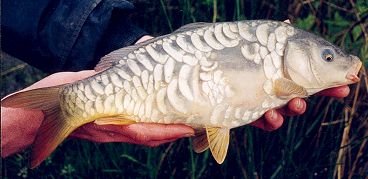If the salmon is the king of freshwater fish, carp can claim the title of the queen. Its fighting capabilities and hardiness are legendary, yet the carp is also graceful and cautious, The widespread release of carp into stillwater fisheries has revolutionised coarse angling in Britain, be it for specimen-sized individuals or for much smaller and more obliging fish.

Barbules & scales
Other than crucian carp – which grow to much smaller sizes and lack the two pairs of a fleshy barbules which their larger cousins possess around their mouths – carp cannot be confused with any other fish. The original, so-called ‘wild’ carp were fully scaled and slow growing, but selective breeding for human food resulted in the development of four separate, faster-growing and often hump-backed genetic forms of the same species:
- totally scaled fish (commons);
- fish with scattered scales (mirrors);
- ‘line’ carp (or linears) on which there is a single row of plate-like scales along each flank;
- ‘nude’ (or leather) carp which have no scales whatsoever. The colour of carp is variable and genetically linked, with distinct brown, gold, slate-blue and grey forms.
Getting the fin over
Despite what is sometimes written, carp can spawn successfully in British waters providing the water temperature reaches at least 17-18°C. However, the survival of young fry is governed by the availability of planktonic food items. Usually, the fry do not obtain enough of these minute animals during the summer months to enable them to build up sufficient food reserves to ensure their first winter survival – hence a massive (and often total) mortality of these small fish.
Sound of silence
The carp’s power of cunning is not merely a figment of the imagination. The fish possess a series of small bones, known as Weberian ossicles, which connect the swim bladder to the inner ear and serve to amplify sound. It is notable that, more so than any other coarse fish, carp can hear sounds of the same wavelengths as humans.
Although carp have a growth span of about 15 years, they may live considerably longer – carp of at least 50 years are thought to be present in several British fisheries. Growth is governed by food availability and water temperature, carp growing fastest at 25-26°C. The warmer weather is the main reason why carp grow larger in some other countries, where 70lb+ fish have been caught by anglers.
–*–
If you are interested in cheap carp fishing tackle and bait, please click here.




















